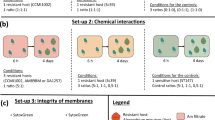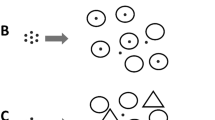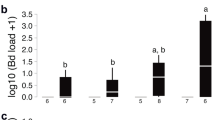Abstract
Pfiesteria piscicida and P. shumwayae reportedly secrete potent exotoxins thought to cause fish lesion events, acute fish kills and human disease in mid-Atlantic USA estuaries1,2,3,4,5,6,7. However, Pfiesteria toxins have never been isolated or characterized8. We investigated mechanisms by which P. shumwayae kills fish using three different approaches. Here we show that larval fish bioassays conducted in tissue culture plates fitted with polycarbonate membrane inserts exhibited mortality (100%) only in treatments where fish and dinospores were in physical contact. No mortalities occurred in treatments where the membrane prevented contact between dinospores and fish. Using differential centrifugation and filtration of water from a fish-killing culture, we produced ‘dinoflagellate’, ‘bacteria’ and ‘cell-free’ fractions. Larval fish bioassays of these fractions resulted in mortalities (60–100% in less than 24 h) only in fractions containing live dinospores (‘whole water’, ‘dinoflagellate’), with no mortalities in ‘cell-free’ or ‘bacteria’-enriched fractions. Videomicrography and electron microscopy show dinospores swarming toward and attaching to skin, actively feeding, and rapidly denuding fish of epidermis. We show here that our cultures of actively fish-killing P. shumwayae do not secrete potent exotoxins; rather, fish mortality results from micropredatory feeding.
This is a preview of subscription content, access via your institution
Access options
Subscribe to this journal
Receive 51 print issues and online access
$199.00 per year
only $3.90 per issue
Buy this article
- Purchase on Springer Link
- Instant access to full article PDF
Prices may be subject to local taxes which are calculated during checkout




Similar content being viewed by others
References
Burkholder, J. M., Noga, E. J., Hobbs, C. H. & Glasgow, H. B. Jr New “phantom” dinoflagellate is the causative agent of major estuarine fish kills. Nature 358, 407–410 (1992)
Burkholder, J. M., Glasgow, H. B. Jr & Hobbs, C. B. Fish kills linked to a toxic ambush-predator dinoflagellate: distribution and environmental conditions. Mar. Ecol. Prog. Ser. 124, 43–61 (1995)
Glasgow, H. B. Jr, Burkholder, J. M., Schmechel, D. E., Tester, P. E. & Rublee, P. A. Insidious effects of a toxic estuarine dinoflagellate on fish survival and human health. J. Toxicol. Environ. Health 46, 501–522 (1995)
Noga, E. J., Khoo, L., Stevens, J. B., Fan, Z. & Burkholder, J. M. Novel toxic dinoflagellate causes epidemic disease in estuarine fish. Mar. Pollut. Bull. 32, 219–224 (1996)
Burkholder, J. M., Glasgow, H. B. Jr & Deamer-Melia, N. J. Overview and present status of the toxic Pfiesteria complex (Dinophyceae). Phycologia 40, 186–214 (2001)
Grattan, L. M. et al. Learning and memory difficulties after environmental exposure to waterways containing toxin-producing Pfiesteria or Pfiesteria-like dinoflagellates. Lancet 352, 532–539 (1998)
Grattan, L. M., Oldach, D. & Morris, G. Human health risks of exposure to Pfiesteria piscicida. Bioscience 51, 853–857 (2001)
Moeller, P. D. et al. Current progress in isolation and characterization of toxins isolated from Pfiesteria piscicida. Environ. Health Perspect. 109, 739–743 (2001)
Glasgow, H. B., Burkholder, J. M., Mallin, M. A., Deamer-Melia, N. J. & Reed, R. E. Field ecology of toxic Pfiesteria complex species and a conservative analysis of their role in estuarine fish kills. Environ. Health Perspect. 109, 715–730 (2001)
Noga, E. J., Levine, J. F., Dykstra, M. J. & Hawkins, J. H. Pathology of ulcerative mycosis in Atlantic menhaden. Dis. Aquat. Org. 4, 189–197 (1988)
Dykstra, M. J. et al. Ulcerative mycosis: a serious menhaden disease of the southeastern coastal fisheries of the United States. J. Fish Dis. 12, 175–178 (1989)
Callinan, R. B. in Proc. ODA Regional Sem. Epizootic Ulcerative Syndrome (eds Roberts, R. J., Campbell, B. & MacRae, I. H.) 248–252 (The Aquatic Animal Health Research Institute, Bangkok, 1994)
Blazer, V. S. et al. Aphanomyces as a cause of ulcerative skin lesions of menhaden from Chesapeake Bay tributaries. J. Aquat. Anim. Health 11, 340–349 (1999)
Blazer, V. S. et al. Aphanomyces invadans in Atlantic menhaden along the East Coast of the United States. J. Aquat. Anim. Health 14, 1–10 (2002)
Kiryu, Y., Shields, J. D., Vogelbein, W. K., Zwerner, D. E. & Kator, H. Induction of skin ulcers in Atlantic menhaden by injection and water-borne exposure to the zoospores of Aphanomyces invadans. J. Aquat. Anim. Health 14, 11–24 (2002)
Vogelbein, W. K., Shields, J. D., Haas, L. W., Reece, K. S. & Zwerner, D. E. Skin ulcers in estuarine fishes: A comparative pathological evaluation of wild and laboratory-exposed fish. Environ. Health Perspect. 109, 687–693 (2001)
Schnepf, E. & Deichgräber, G. “Myzocytosis”, a kind of endocytosis with implications on compartmentation in endosymbiosis. Observations in Paulsenella (Dinophyta). Naturwissenschaften 71, 218–219 (1983)
Glasgow, H. B., Burkholder, J. M., Morton, S. L. & Springer, J. A second species of ichthyotoxic Pfiesteria (Dinamoebales, Dinophyceae). Phycologia 40, 234–245 (2001)
Burkholder, J. M., Marshall, H. G., Glasgow, H. B., Seaborn, D. W. & Deamer-Melia, J. The standardized fish bioassay procedure for detecting and culturing actively toxic Pfiesteria, used by two reference laboratories for Atlantic and Gulf Coast states. Environ. Health Perspect. 109, 745–756 (2001)
Spero, H. J. & Moree, M. D. Phagotrophic feeding and its importance to the life cycle of the holozoic dinoflagellate, Gymnodinium fungiforme. J. Phycol. 17, 43–51 (1981)
Schnepf, E. & Elbrächter, M. Nutritional strategies in dinoflagellates—a review with emphasis on cell biological aspects. Eur. J. Protistol. 28, 3–24 (1992)
Vogelbein, W. K. et al. in Agenda: Symp. Harmful Marine Algae in the U.S. 81 (The Marine Biological Laboratory, Woods Hole, Massachusetts, 2000).
Shumway, S., Springer, J., Burkholder, J. M., Glasgow, H. B. in Agenda: Symp. Harmful Marine Algae in the U.S. 64 (The Marine Biological Laboratory, Woods Hole, Massachusetts, 2000).
Melo, A. C., Moeller, P. R., Glasgow, H. B., Burkholder, J. M. & Ramsdell, J. S. Microfluorimetric analysis of a purinergic receptor (P2X7) in GH4C1 rat pituitary cells: Effects of a bioactive substance produced by Pfiesteria piscicida. Environ. Health Perspect. 109, 731–737 (2001)
El-Nabawi, A. et al. The N-methyl-d-aspartate neurotransmitter receptor is a mammalian brain target for the dinoflagellate Pfiesteria piscicida toxin. Toxicol. Appl. Pharmacol. 169, 84–93 (2000)
Marshall, H. M. et al. Comparative culture and toxicity studies between the toxic dinoflagellate, Pfiesteria piscicida, and a morphologically similar cryptoperidiniopsoid dinoflagellate. J. Exp. Mar. Biol. Ecol. 255, 65–74 (2000)
Burkholder, J. M. & Glasgow, H. B. Pfiesteria piscicida and other toxic Pfiesteria-like dinoflagellates: behaviour, impacts and environmental controls. Limnol. Oceanogr. 42, 1052–1075 (1997)
Litaker, R. W., Vandersea, M. W., Kibler, S. R., Madden, V. J., Noga, E. J. & Tester, P. A. Life cycle of the heterotrophic dinoflagellate Pfiesteria piscicida (Dinophyceae). J. Phycol. 38, 442–463 (2002)
Berry, J. P. et al. Are Pfiesteria species toxicogenic? Evidence against production of ichthyotoxins by Pfiesteria shumwayae. Proc. Natl Acad. Sci. USA (in the press)
Steidinger, K. A. et al. Pfiesteria piscicida gen. et. sp. nov. (Pfiesteriaceae fam. nov.), a new toxic dinoflagellate with a complex life cycle and behaviour. J. Phycol. 32, 157–164 (1996)
Acknowledgements
C. Squyars, A. Miller, P. Blake, D. Zwerner, E. Westcott, V. Foster, L. Ott, E. Walker, J. Watts, W. Ribeiro and K. Hudson contributed significantly to this investigation. E. M. Burreson provided support and critical review. This work was funded in part by ECOHAB (Ecology and Oceanography of Harmful Algal Blooms) grants from the EPA, the EPA with the National Oceanic and Atmospheric Administration (NOAA), and from the NOAA; the Commonwealth of Virginia's Pfiesteria Initiative; and the Centers for Disease Control and Prevention. We thank T. Shedd and the US Army Center for Environmental Health Research for the lease of the BSL3 laboratory.
Author information
Authors and Affiliations
Corresponding author
Ethics declarations
Competing interests
The authors declare that they have no competing financial interests.
Rights and permissions
About this article
Cite this article
Vogelbein, W., Lovko, V., Shields, J. et al. Pfiesteria shumwayae kills fish by micropredation not exotoxin secretion. Nature 418, 967–970 (2002). https://doi.org/10.1038/nature01008
Received:
Accepted:
Published:
Issue Date:
DOI: https://doi.org/10.1038/nature01008
This article is cited by
-
Making a Lecture Stick: the Effect of Spaced Instruction on Knowledge Retention in Medical Education
Medical Science Educator (2020)
-
Marine microalgae attack and feed on metazoans
The ISME Journal (2012)
-
The acquisition of phototrophy: adaptive strategies of hosting endosymbionts and organelles
Photosynthesis Research (2011)
-
Coastal and estuarine ecological risk assessment: the need for a more formal approach to stressor identification
Hydrobiologia (2007)
-
Are Pfiesteria species toxicogenic? Evidence against production of icthyotoxins by Pfiesteria shumwayae
Nature (2002)
Comments
By submitting a comment you agree to abide by our Terms and Community Guidelines. If you find something abusive or that does not comply with our terms or guidelines please flag it as inappropriate.



